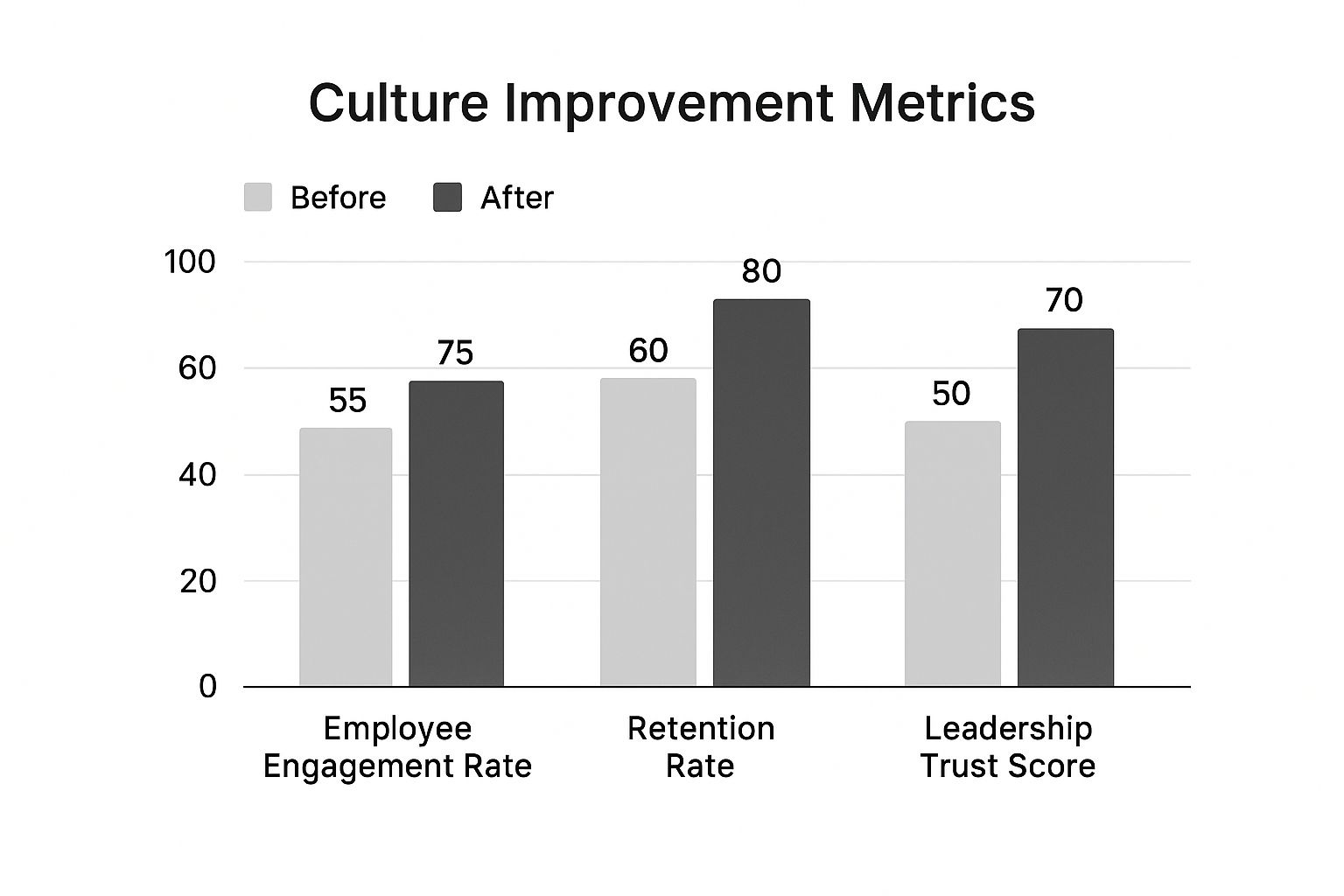How to Improve Workplace Culture That Actually Lasts
Improving your workplace culture is so much more than adding a few new perks or company-wide happy hours. It’s about making a real, strategic investment in your people through authentic leadership, genuine well-being initiatives, and meaningful opportunities for them to grow. This is what truly builds a thriving, productive environment where people feel valued and, as a result, want to do their best work.
Why Investing in Culture Is a Non-Negotiable Strategy
Let's cut right to the chase. Thinking about workplace culture as a "nice-to-have" or some fluffy HR initiative is a surefire way to fall behind. It’s a core business strategy, plain and simple, with a direct and measurable impact on your bottom line.
A toxic environment actively drains your company's resources through high turnover, disengagement, and plummeting productivity. On the flip side, a thriving culture becomes your most powerful engine for innovation, talent retention, and sustainable growth. It’s that simple.
Ignoring the health of your culture is like ignoring a strange noise coming from your car's engine; eventually, it’s going to break down. When employees are constantly stressed, undervalued, or disconnected from the company's mission, their performance will inevitably suffer. The proof is in the numbers: organizations with a strong, positive culture see 33% higher revenue. That's no accident. It’s the direct result of creating a place where people are empowered to excel.
The Real Cost of a Bad Culture
A negative culture isn't just unpleasant—it's expensive. It creates friction that shows up in several costly ways:
- High Employee Turnover: Every time someone walks out the door, it costs you. Replacing an employee can run a significant portion of their annual salary, and a poor culture is one of the top reasons people start looking for a new job.
- Widespread Burnout: A "work until you drop" mentality and a lack of appreciation are a recipe for burnout, which absolutely crushes productivity and morale. We've gone into detail on the detrimental effects of overworking employees if you want to dig deeper into that topic.
- Stifled Innovation: When people are afraid to fail or feel like their ideas will be shot down, they simply stop contributing. You need psychological safety—a cornerstone of a great culture—for fresh, game-changing ideas to ever see the light of day.
The Tangible ROI of a Great Culture
Now for the good news. Investing in your culture pays dividends you can actually see on a balance sheet. When you get it right, you're not just making people happier; you're building a more resilient, high-performing organization.
To build a truly thriving culture, leaders need to focus on a few key areas that work together. I've broken down these essential components below.
Core Pillars of a Thriving Workplace Culture
| Pillar | Core Action | Expected Outcome |
|---|---|---|
| Authentic Leadership | Lead with empathy, transparency, and consistency. Model the behaviors you want to see. | Increased trust, psychological safety, and employee buy-in to the company vision. |
| Employee Well-being | Prioritize mental and physical health. Promote a healthy work-life balance. | Reduced burnout, lower absenteeism, and a more energized, resilient workforce. |
| Meaningful Recognition | Acknowledge and reward contributions in a timely, specific, and genuine way. | Higher morale, increased motivation, and stronger employee loyalty. |
| Open Communication | Establish clear, consistent channels for feedback and dialogue at all levels. | Better alignment, faster problem-solving, and an environment where everyone feels heard. |
Focusing on these pillars doesn't just feel good; it drives tangible business results. They are the foundation upon which a truly exceptional workplace is built.
"A great culture isn't about free snacks and ping-pong tables. It's about creating an environment where every single employee feels seen, heard, and empowered to contribute to a shared mission. That's where the real magic happens."
Just look at the data below. It shows what can happen when an organization gets serious about its cultural initiatives.

The chart couldn't be clearer: targeted efforts to improve workplace culture lead directly to higher engagement, better retention, and increased trust in leadership. These aren't just vanity metrics; they are the key drivers of business success. Throughout this guide, we’ll explore the practical, actionable steps you can take to achieve these exact results for your own team.
Build a Foundation of Unshakeable Trust

When we talk about improving workplace culture, trust is the bedrock. It’s not just a nice-to-have; it's the invisible glue holding everything together. Without it, even the most brilliant strategies and well-intentioned perks will fall flat.
But trust isn't something you can declare in a mission statement. It’s earned in the trenches, through the day-to-day actions and decisions made by leaders. It’s all about creating an environment of psychological safety—a space where people feel safe enough to voice a crazy idea, admit they messed up, or challenge the status quo without fearing retribution.
Think of it this way: a high-trust environment is a greenhouse where innovation can actually grow. A low-trust one is a frozen tundra where nothing, no matter how promising, can take root. The difference is that stark, and it has a direct line to your team's performance.
Embrace Radical Transparency, Especially When It’s Hard
Real transparency isn’t just about sharing the wins. It’s about being honest when the chips are down. How you communicate tough news—a strategic pivot, departmental restructuring, or missed targets—is a defining moment for any leader.
Don't hide behind corporate jargon or let the rumor mill do your job for you. Get out in front of it. Explain the "why" behind the decision, be frank about the challenges ahead, and give your team a clear picture of the path forward. This shows you respect them as partners, not just as cogs in a machine.
Let's imagine your team missed its sales goals for the quarter.
- The Low-Trust Play: Management goes quiet, letting anxiety and speculation fill the void. When the news finally drops, it’s loaded with blame and pressure.
- The High-Trust Play: The leader pulls the team together, lays out the numbers openly, and takes ownership of their part in the miss. Then, they turn it into a brainstorm: "What can we, as a team, do differently next quarter?"
This simple shift turns a failure into a collaborative learning experience, building resilience and deepening trust. It proves you're all in it together.
Run Authentic "Ask Me Anything" Sessions
An "Ask Me Anything" (AMA) session with leadership can be a game-changer for building trust, but only if it's genuinely open. It’s your chance to prove you’re accessible and not afraid of the tough questions.
For these to work, you need a couple of ground rules. First, no question is off-limits (within professional reason, of course). Second, leaders must commit to giving straight, honest answers—even if that answer is, "I don't have an answer yet, but here’s how we're going to figure it out."
When employees see leaders field difficult questions without getting defensive, it shatters the invisible wall between management and the rest of the team. It sends a powerful message: your voice matters and your concerns are heard.
This practice is a direct antidote to the "us vs. them" mentality that can poison a company's culture. It shows leaders are human, vulnerable, and ultimately, far more trustworthy.
Maintain Predictable and Consistent Leadership
Few things create more anxiety at work than an inconsistent leader. If your team doesn't know which version of their manager is going to walk through the door each day, they'll spend more energy trying to read the room than doing great work.
Predictability isn't about being a robot; it's about being reliable. Your team should have a solid understanding of your values, your decision-making process, and how you’ll react to both wins and losses. This consistency gives them a stable platform to stand on.
What predictable leadership looks like in action:
- Fairness in Promotions: When people trust the process, they are 2.6 times more likely to believe promotions are fair. A consistent and transparent path to advancement is non-negotiable.
- How You Handle Mistakes: A predictable leader treats a mistake as a coaching moment, not a "gotcha" moment. This fosters accountability instead of fear.
- Living the Company Values: Your decisions should consistently echo the company's stated values, proving they’re more than just posters on a wall.
When trust becomes the default setting in your organization, everything changes for the better. People feel empowered to take real ownership, knowing they have the support and autonomy they need. That freedom is what unlocks the kind of discretionary effort that separates the good companies from the truly great ones.
Champion Employee Well-Being and Mental Health
A truly great workplace culture is built on a foundation of healthy, happy, and resilient people. Let’s be honest: a fruit bowl in the breakroom or a subscription to a wellness app, while nice gestures, just won't cut it. To really move the needle, well-being can't be an afterthought. It has to be woven into the very fabric of your company.
This is about shifting from reactive, band-aid solutions to proactively creating an environment where employees feel genuinely safe and supported. It means building a place where talking about mental health is just as normal as talking about a project deadline. When your team's holistic health becomes a shared priority, the positive effects will ripple through every part of the business, from engagement all the way to retention.
This isn't just a fleeting trend; it's a core business strategy. The data backs this up. 87% of companies now have formal wellness programs, and 77% of employees say these initiatives have a positive impact on their work environment. With 72% of employers calling employee well-being a top priority and 69% of HR leaders directly linking these programs to better retention, it’s clear: investing in your people’s health is a direct investment in your company's future.
Create a Psychologically Safe Environment
It all starts with psychological safety. This is the bedrock of a healthy culture. It’s the shared belief that you won’t be punished or shamed for speaking up—whether it's with a new idea, a tough question, a concern, or even a mistake.
Leaders are the key here. When a manager openly admits they're feeling stressed or shares that they’re taking a mental health day, it sends a powerful signal to the whole team: it’s okay to be human. That kind of vulnerability is what dismantles the stigma that so often poisons the well.
Here’s how you can start fostering this kind of safety:
- Walk the Talk: Leaders need to model healthy boundaries. A manager who logs off at 5 p.m. and encourages their team to do the same makes a much bigger impact than any written policy ever could.
- Listen with Empathy: Train your managers to truly listen—without judgment—when an employee comes to them with a concern.
- Embrace No-Blame Post-Mortems: When a project goes south, the conversation should always be, "What can we learn?" not "Whose fault was it?" This builds trust and encourages people to take smart risks.
Train Managers to Spot and Address Burnout
Your managers are on the front lines. They’re usually the first to see the subtle signs that an employee is struggling. The problem is, most have never been trained to handle these delicate situations.
This isn’t about turning your managers into therapists. It’s about equipping them to recognize the early warning signs of burnout and stress so they can intervene with support, not suspicion.
Keep an eye out for these key signs:
- A noticeable dip in productivity or the quality of their work.
- Uncharacteristic irritability, cynicism, or emotional withdrawal.
- A pattern of absenteeism or disengaging from team activities.
Once they spot these signs, managers need to know how to start a supportive, private conversation. The goal should be to ask, "How can I support you?" instead of demanding, "What's wrong with you?" Giving them a simple framework for these talks and a clear list of available company resources (like an EAP or flexible work options) is absolutely essential. If you're in a leadership role, you can get more practical advice in our guide with 5 tips to foster mental health at work.
Implement Flexible Policies That Promote Balance
Real work-life balance isn't a perfect 50/50 split. It’s about having the flexibility to manage life's demands without feeling like you're failing at everything. Rigid, one-size-fits-all policies often create more stress than they solve.
A truly supportive culture acknowledges that life happens. It provides the flexibility for an employee to attend a parent-teacher conference, go to a doctor's appointment, or simply take a mental health day without a mountain of guilt.
This is where you see the direct link between policy and culture. Offering flexible hours, remote work, or generous paid time off isn't just a perk; it's a declaration of trust. It shows your employees you trust them to manage their time and deliver results.
That feeling of autonomy is a powerful driver of both well-being and performance. When people feel trusted, they’re far more likely to be motivated, engaged, and loyal.
Combat Burnout and Supercharge Engagement

Let's be honest: disengagement is the silent killer of a healthy workplace. It isn’t a loud, dramatic implosion. It's a quiet, slow leak of energy, motivation, and creativity that leaves your teams running on empty. When people feel disconnected and overworked, burnout is right around the corner—and it’s incredibly costly.
The problem is getting worse, not better. Fresh 2025 data shows a pretty grim picture, revealing that a mere 30% of employees across the globe actually feel engaged at work. That's the lowest it's been in over a decade, and it's directly linked to crushing workloads and poor leadership.
The financial hit is staggering. A disengaged employee can cost a company around 34% of their yearly salary in lost productivity alone. On top of that, they are 56% more likely to be actively looking for a new job. And with a shocking 64% of employees reporting burnout at least once a week, it's clear we can't just slap a bandage on this. We need to dig deeper, find the real causes, and make changes that stick.
Connect Daily Tasks to the Bigger Picture
One of the fastest ways to kill motivation is when someone feels like their work is just… busywork. If an employee can’t see the thread connecting their daily to-do list to the company's grander mission, their tasks just become a grind. The "why" is missing, and so is their drive.
This is where great leaders step in. It's your job to constantly and clearly draw a line from what an individual is doing to what the team is trying to achieve, and from there, to the company's overall vision. Don't ever assume they see the connection on their own. Spell it out for them.
For instance, instead of just assigning a report, frame it with purpose: "This analysis is absolutely critical. It's going to help us pinpoint our top customer pain points, which is a direct shot at our goal of boosting retention by 15% this year." Suddenly, it’s not just a report; it's a key move in a much bigger game.
Stop Wasting Time in Bad Meetings
We've all been there—stuck in a pointless meeting that drains your will to live. These meetings are a top contributor to frustration and burnout, stealing precious time and breaking everyone's focus. If you want to improve your culture, you have to reclaim this time.
Here's a simple but powerful fix: demand a clear agenda and a stated goal for every single meeting. If a meeting doesn't have a clear purpose, it shouldn't be on the calendar. Period.
Consider making these your new meeting ground rules:
- No Agenda, No Attenda: Make it a cultural norm. If an invite lands in your inbox without a clear agenda and desired outcome, you have permission to decline.
- The Two-Pizza Rule: It's a classic for a reason. If you can't feed the entire meeting with two pizzas, you have too many people in the room. This forces you to keep meetings small, focused, and efficient.
- End with Action: Every meeting must end with a quick summary of what was decided, who is responsible for what, and by when.
This approach shows you respect everyone's time and turns meetings from a source of dread into a genuinely productive tool. For more ideas on how to improve workplace safety and efficiency, you might be interested in our article on how metropolitan cities should approach road protection.
Build Engagement from the Ground Up with Peer Recognition
Top-down recognition from a manager is great, but creating a system for peer-to-peer appreciation? That's a total game-changer for engagement. When you empower colleagues to celebrate each other's wins, you build an incredible sense of camaraderie and shared success.
This doesn't need to be some complicated, expensive program. It can be as simple as a dedicated Slack channel for shout-outs or a "Kudos" board in the breakroom. The goal is to make recognition easy, visible, and frequent.
When employees feel seen for their hard work, they are 2.2 times more likely to be the ones driving innovation and bringing fresh ideas to the table. A culture of recognition is what fuels that extra effort that separates a good company from a great one.
A fantastic real-world example is Atlassian’s "Kudos" program, which allows any employee to give props to a colleague for going above and beyond. This simple act of peer-to-peer praise strengthens working relationships and reinforces the exact behaviors you want to see repeated across the company. It creates a positive feedback loop that builds on itself—and that's how you truly supercharge engagement.
Create Clear Pathways for Growth and Development

Let's be honest—your best employees aren't just looking for a paycheck. They want a career. If they can’t see a clear future with you, they'll eventually find one with someone else. A culture where people feel stuck is one of the fastest ways to lose great talent and end up with a team that's just going through the motions.
To build a workplace culture that actually sticks, learning and development need to be woven into the fabric of your company. This is about so much more than an annual training budget. It’s about creating visible, exciting career paths that show your team exactly how they can grow with you. It proves you're invested in them for the long haul.
This isn't just a feel-good initiative; it's a powerful retention strategy. Global trends are screaming this from the rooftops: growth opportunities are a huge driver of employee loyalty. In fact, a staggering 40% of employees say they would think about leaving their job if their employer didn't offer opportunities to upskill or reskill. The message is clear: development builds trust, and trust is the bedrock of a positive culture.
Map Out Visible Career Paths
Telling an employee "there's room to grow here" is one thing. Showing them exactly what that growth looks like is something else entirely. Vague promises just breed uncertainty and frustration. What you need are transparent career lattices—not just old-school ladders.
A career lattice gives a much broader, more realistic view of potential. It shows both vertical promotions and horizontal moves. For instance, a rockstar on your customer support team might not want to be a manager, but their skills could make them an incredible fit for a role in product testing or UX design.
When you map these pathways out, you're handing your team a roadmap. Suddenly, their professional development goals become tangible and actionable because they can see exactly what skills they need to get to the next level.
Launch a Mentorship Program That Clicks
Formal training has its place, but nothing beats learning from someone who has been there and done that. A strong mentorship program is a game-changer for passing on institutional knowledge, honing leadership skills, and forging deeper connections across your organization.
But a mentorship program is only as good as its pairings. Don't just assign mentors based on seniority. To create connections that actually work, think about:
- Shared Goals: Pair a junior employee with a senior colleague who's an expert in the area the mentee is passionate about.
- Complementary Skills: Match a creative, big-picture thinker with a detail-oriented planner. They'll both learn a new way to approach problems.
- Personal Chemistry: If you can, let people have some say in the process. A natural rapport makes all the difference.
A well-designed mentorship program does more than just train your junior talent. It re-energizes your senior leaders, giving them a meaningful way to shape the next generation and strengthening their own bond with the company.
This two-way street of learning and guidance is a cornerstone of a supportive, growth-focused culture.
Empower Your Team with Upskilling Initiatives
In a world where skills have a shorter shelf life than ever, being proactive about upskilling is non-negotiable. When you empower your employees with the tools to learn, you're not just preparing them for their next role—you're preparing them for the future of work itself.
This can take many forms. You could provide access to online learning platforms, sponsor certifications, or host in-house workshops led by your own experts. The key is to make learning accessible and relevant to both the employee's aspirations and the company's strategic needs. We dive deeper into this topic in our article on the importance of professional development for employees.
When you truly invest in your people’s growth, you send a powerful message: you are our most valuable asset. That feeling of being valued is what turns a job into a career, creating a loyal, motivated, and skilled team that will carry your company forward.
Common Questions About Building a Better Culture
Even with the best game plan, trying to shift a workplace culture brings up some tough, real-world questions. I've been there. You hit roadblocks you didn't see coming. Let's tackle some of the most common hurdles leaders run into when they're working to make their company a better place to be.
What If Key Managers Resist the Change?
This is a classic—and tricky—problem. When a manager digs in their heels and refuses to get on board with cultural changes, it can bring everything to a grinding halt for their entire team.
Before you jump to conclusions, your first move should be to figure out why they're pushing back. More often than not, it’s not about defiance. It’s usually rooted in a fear of losing control, a genuine misunderstanding of the goals, or just plain skepticism because they’ve seen other initiatives fizzle out before.
Sit down with them, one-on-one. Have a real conversation. Instead of lecturing, try to connect the new cultural values to what they care about: their team’s performance and their own success. Show them, with clear examples, how a more engaged and trusting environment will actually make their job easier and their people more effective.
If that conversation doesn't move the needle, you have to be direct. Part of their job as a leader is to champion the company's direction. Make it clear that modeling these new behaviors isn't optional—it's a core expectation of their role.
How Can We Improve Culture on a Tight Budget?
This is a question I hear all the time, and the answer is surprisingly simple: some of the most powerful culture-building moves are completely free. A great culture is built on daily behaviors and genuine interactions, not expensive perks.
If you're working with a shoestring budget, pour your energy into high-impact actions that don't cost a dime.
Here are a few ideas to get you started:
- Launch a Peer-to-Peer Shout-Out System: This can be as simple as a dedicated channel on Slack or a physical whiteboard in a common area. When people can easily and publicly recognize a colleague's great work, appreciation becomes a natural part of your daily workflow.
- Fix Your Meeting Culture: This is a big one. Institute a "no agenda, no attenda" rule. Start and end on time, every time. Showing you respect people's time is one of the most powerful (and free) ways to boost morale.
- Make Leaders More Accessible: Have your senior leaders host regular, informal "Ask Me Anything" (AMA) sessions. An open, honest dialogue builds trust way more effectively than a fancy, off-site team-building day ever could.
A genuine, timely "thank you" from a manager is one of the most effective motivators there is. Research shows that this simple act can significantly increase an employee's willingness to go the extra mile. Don’t underestimate the power of authentic appreciation.
How Do We Know if Our Efforts Are Working?
It's tough to see the forest for the trees when you're in the middle of a big change. The trick is to know what to look for. While you'll eventually see shifts in big-picture metrics like retention rates, the earliest signs of progress are usually much more subtle.
Start by just listening. What’s the "water cooler" talk sound like now? Are conversations more positive? Are people from different departments actually collaborating instead of staying in their silos? These are the first green shoots. For more structured feedback, you can learn more about how to measure employee satisfaction with targeted surveys and check-ins.
Pay close attention to what happens in your meetings. Are more people speaking up, sharing ideas, and even offering constructive pushback? That's a golden indicator that psychological safety is improving. Ultimately, you'll know you've succeeded when your team starts holding each other accountable to the new standards. That’s when you know it's not just your vision anymore—it's a shared reality.
Ready to build a workplace where everyone thrives? At JIMAC10, we provide stories, insights, and practical guidance to help you cultivate a positive and productive environment. Explore our resources at https://jimac10.tube and start your journey today.
Share this content:







































1 comment